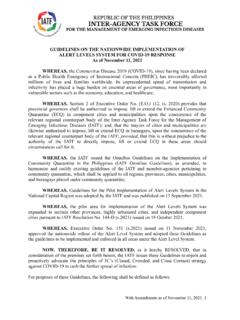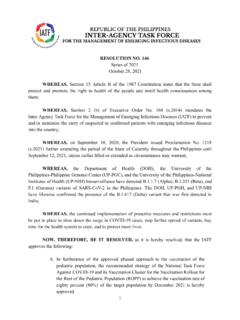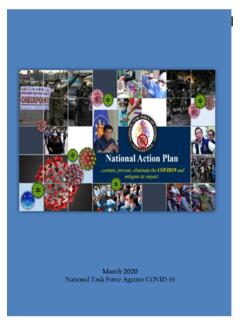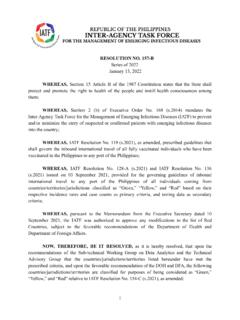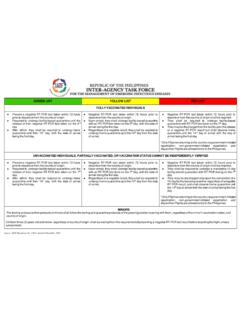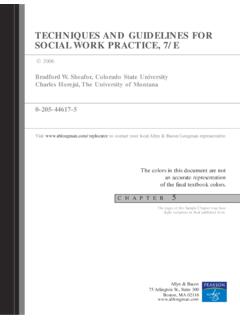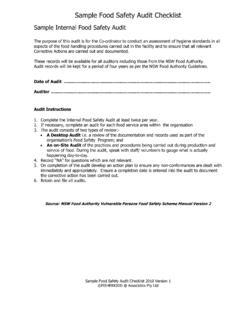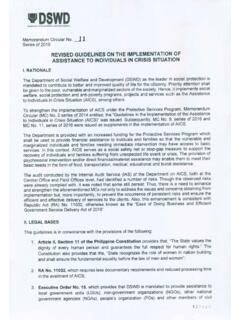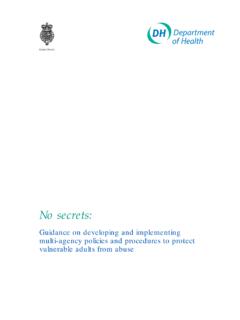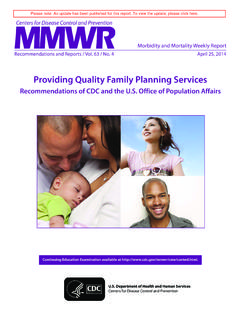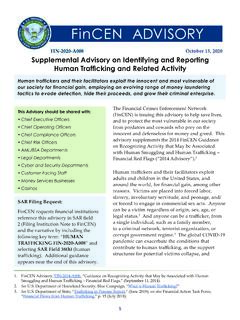Transcription of Guidelines for Nationwide Alert Level System as of 27 Feb 2022
1 Guidelines ON THE Nationwide IMPLEMENTATION OF. Alert Level System FOR COVID-19 RESPONSE. As of February 27, 2022. WHEREAS, the Coronavirus Disease 2019 (COVID-19), since having been declared as a Public Health Emergency of International Concern (PHEIC), has irreversibly affected millions of lives and families worldwide. Its unprecedented speed of transmission and infectivity has placed a huge burden on essential areas of governance, most importantly in vulnerable sectors such as the economy, education, and healthcare;. WHEREAS, Section 2 of Executive Order No. ( ) 112, (s. 2020) provides that provincial governors shall be authorized to impose, lift or extend the Enhanced Community Quarantine (ECQ) in component cities and municipalities upon the concurrence of the relevant regional counterpart body of the Inter-Agency Task Force for the Management of Emerging Infectious Diseases (IATF); and, that the mayors of cities and municipalities are likewise authorized to impose, lift or extend ECQ in barangays, upon the concurrence of the relevant regional counterpart body of the IATF; provided, that this is without prejudice to the authority of the IATF to directly impose, lift or extend ECQ in these areas should circumstances call for it.
2 WHEREAS, the IATF issued the Omnibus Guidelines on the Implementation of Community Quarantine in the Philippines (IATF Omnibus Guidelines ), as amended, to harmonize and codify existing Guidelines of the IATF and member-agencies pertaining to community quarantine, which shall be applied to all regions, provinces, cities, municipalities, and barangays placed under community quarantine;. WHEREAS, Guidelines for the Pilot Implementation of Alert Level System in the National Capital Region was adopted by the IATF and was published on 13 September 2021. WHEREAS, the pilot area for implementation of the Alert Level System was expanded to include other provinces, highly urbanized cities, and independent component cities pursuant to IATF Resolution No. 144-D ( ) issued on 18 October 2021. WHEREAS, Executive Order No.
3 151 ( ) issued on 11 November 2021, approved the Nationwide rollout of the Alert Level System and adopted these Guidelines as the Guidelines to be implemented and enforced in all areas under the Alert Level System . WHEREAS, Section 6 of Executive Order No. 151 ( ) further provides that Executive Order No. 112 ( ) shall be deemed repealed once all areas of the country are placed under the Alert Level System . NOW, THEREFORE, BE IT RESOLVED, as it hereby RESOLVED, that in consideration of the premises set forth herein, the IATF issues these Guidelines to enjoin and With Amendments as of February 27, 2022. 1. proactively advocate the principles of 3C's (Closed, Crowded, and Close Contact) strategy against COVID-19 to curb the further spread of infection: For purposes of these Guidelines , the following shall be defined as follows: 1.
4 Accommodation Establishments - refers to establishments operating primarily for accommodation purposes including, but not limited to, hotels, resorts, apartment hotels, tourist inns, motels, pension houses, private homes used for homestay, ecolodges, serviced apartments, condotels, and bed and breakfast facilities. 2. COVID-19 - refers to the Coronavirus Disease 2019 which is caused by the virus known as the severe acute respiratory syndrome coronavirus 2 (SARS-CoV-2). 3. COVID-19 Alert Level System - refers to the new Community Quarantine Classifications for dealing with COVID-19 covering entire cities, municipalities and/or regions; aimed to manage and minimize the risk of the disease through System Indicators, Triggers and Thresholds determined by the IATF to specify the public health and social measures to be taken in relation to the COVID-19 response, as may be updated based on new scientific knowledge, information about the effectiveness of control measures in the country and overseas, and its application.
5 A. Alert Level 1 - refers to areas wherein case transmission is low and decreasing, total bed utilization rate, and intensive care unit utilization rate is low. b. Alert Level 2 - refers to areas wherein case transmission is low and decreasing, healthcare utilization is low, or case counts are low but increasing, or case counts are low and decreasing but total bed utilization rate and intensive care unit utilization rate is increasing. c. Alert Level 3 - refers to areas wherein case counts are high and/or increasing, with total bed utilization rate and intensive care unit utilization rate at increasing utilization. d. Alert Level 4 - refers to areas wherein case counts are high and/or increasing, with total bed utilization rate and intensive care unit utilization rate at high utilization. e. Alert Level 5 - refers to areas wherein case counts are alarming, with total bed utilization rate and intensive care unit utilization rate at critical utilization.
6 With Amendments as of February 27, 2022. 2. 4. Essential goods and services - covers health and social services to secure the safety and well-being of persons , such as but not limited to, food , water, medicine, medical devices, public utilities, energy, and others as may be determined by the IATF. 5. Granular Lockdown - refers to a micro- Level quarantine for areas identified as "critical zones" by the local government unit (LGU) which may be declared regardless of Alert Level . 6. Health and emergency frontline services - refers to services provided by public health workers [all employees of the DOH, DOH Hospitals, Hospitals of LGUs, and Provincial, City, and Rural Health Units, and Drug Abuse Treatment and Rehabilitation Centers including those managed by other government agencies ( police and military hospitals/clinics, university medical facilities), uniformed medical personnel], private health workers, such as but not limited to medical professionals, hospital and health facility administrative and maintenance staff, and aides from private health facilities, as well as their service providers, health workers and volunteers of the Philippine Red Cross and the World Health Organization, and employees of Health Maintenance Organizations (HMOs)
7 , the Philippine Health Insurance Corporation (PHIC), health insurance providers, disaster risk reduction management officers, and public safety officers. 7. Minimum public health standards (MPHS) - refers to the national, local, and sector-specific Guidelines on mitigation measures for its COVID-19 response across all settings by implementing non-pharmaceutical interventions (NPIs), consistent with the Department of Health (DOH) Administrative Order No. 2021-0043 or the Omnibus Guidelines on the Minimum Public Health Standards for the Safe Reopening of Institutions. This term shall also encompass specific NPIs of community mitigation strategies or public health measures that do not involve vaccines, medications, or other pharmaceutical interventions, that individuals and communities can carry out in order to reduce transmission rates, contact rates, and the duration of infectiousness of individuals in the population.
8 8. On-site capacity - refers to the number of employees or workers who can be permitted or required to be physically present at their designated workplace outside of their residences. 9. Skeleton workforce - refers to the on-site capacity which utilizes the smallest number of people needed for a business or organization to maintain its basic functions. With Amendments as of February 27, 2022. 3. PART I. Alert Level System FOR COVID-19 RESPONSE. SECTION [1] GENERAL Guidelines . 1. The DOH, shall identify the Alert Level of the areas. These areas shall follow the protocols consistent with the declared Alert Level . 2. LGUs shall submit on a daily basis to their respective Regional Inter-Agency Task Force (RIATF) such data as determined by National Government Agencies based on the template provided for by the IATF Sub-Technical Working Group on Data Analytics.
9 3. MPHS shall be implemented at all times consistent with the DOH Administrative Order No. 2021-0043 or the Omnibus Guidelines on the Minimum Public Health Standards for the Safe Reopening of Institutions. 4. The benefits for hazard pay and special risk allowances for all personnel in health facilities shall be applicable under the Alert Level System for the duration of the state of Public Health Emergency due to COVID-19. 5. Only hotels or accommodation establishments with valid DOT Accreditation shall be allowed to accommodate guests and clients subject to Guidelines issued by the Department of Tourism and the IATF. 6. In all areas not under Alert Level 5, establishments permitted to operate under each Alert Level may be allowed additional venue/seating capacity on top of the existing allowable venue/seating capacities, as follows: a.
10 An additional twenty percent (20%) if the area where such establishments are located has a vaccination coverage above seventy percent (70%) for both Priority Group A2 (senior citizens) and Priority Group A3 (adults with comorbidities), as determined by the Vaccine Cluster of the National Task Force Against COVID-19; and b. An additional ten percent (10%) if said establishments have been awarded Safety Seal Certificates under the Safety Seal Certification Program. 7. LGUs are enjoined to enact the necessary ordinances to enforce protocols contained in these Guidelines and to penalize, in a fair and humane manner, violations of these protocols. Law enforcement agencies are likewise strongly enjoined to observe fair and humane treatment of violators. 8. All national government agencies and instrumentalities, as well as private sector establishments, shall adopt measures to strictly implement and enforce the minimum With Amendments as of February 27, 2022.


